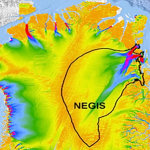
The glaciers of northeast Greenland, long thought to be the most stable part of the massive Greenland ice sheet, are melting at an accelerating pace, losing roughly 10 billion tons of ice annually for the past decade, say researchers from the U.S. and Denmark.

The finding will likely boost estimates of global sea level rise, which had previously not accounted for massive ice loss from that region, scientists say. The Zachariae ice stream in northeast Greenland, which drains 16 percent of the ice sheet, has retreated roughly 12.4 miles during the past decade, outpacing the fast-moving Jakobshavn glacier, which has retreated 21.7 miles over the last 150 years.
Ice loss from the region is likely accelerating, the researchers say, because ice dams in nearby bays that had been blocking the glaciers’ paths are now also melting, freeing the way for them to flow into the ocean.
“Northeast Greenland is very cold—it used to be considered the last stable part of the Greenland ice sheet,” explained the lead researcher of the report, which was published in Nature Climate Change. “This study shows that ice loss in the northeast is now accelerating. So, now it seems that all of the margins of the Greenland ice sheet are unstable.”
Other recent studies had estimated more moderate ice loss from Greenland’s northeast.
Visit EcoWatch’s CLIMATE CHANGE page for more related news on this topic.

[source: http://ecowatch.com/2014/03/18/greenland-glaciers-losing-10-billion-tons-ice/]

Leave a Reply
You must be logged in to post a comment.